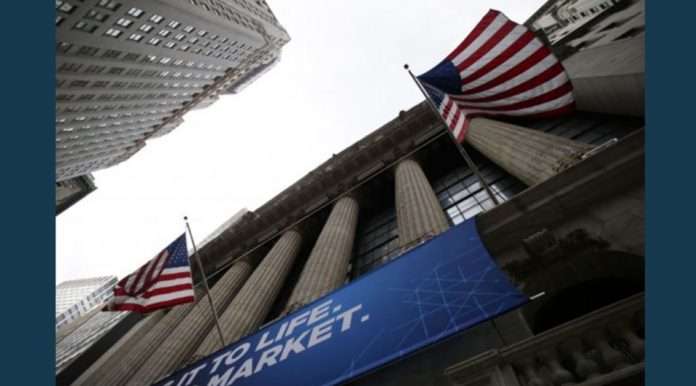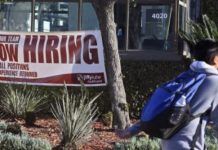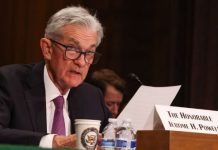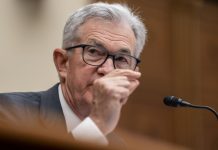
May 4 (UPI) — The Federal Reserve on Wednesday concluded a two-day policy meeting and took a major step against surging inflation by making its highest interest rate hike in decades.
The Fed announced that it’s decided to raise interest rates by a half-point, a move that was widely expected by economists.
In its announcement, the Federal Reserve said that most members of the Federal Open Market Committee felt that the half-point increase is the appropriate action to tame inflation. Before the decision, some analysts said it was possible that the Fed could go for a hike of three-quarters of a point.
After a quarter-point increase at its last meeting in March, the Fed’s move increases rates to between 3/4 and 1%. The half-point increase is the largest since 2000.
“The committee seeks to achieve maximum employment and inflation at the rate of 2% over the longer run. With appropriate firming in the stance of monetary policy, the committee expects inflation to return to its 2% objective and the labor market to remain strong,” the committee said in a statement.
“In support of these goals, the committee decided to raise the target range for the federal funds rate to 3/4 to 1% and anticipates that ongoing increases in the target range will be appropriate.”
The rate hike in March was the Fed’s first since 2018 and followed two years of rate decreases and emergency actions to counter the COVID-19 pandemic. Many investors have said they also expect the Fed to make similar rate increases at each of its next three policy meetings — in June, July and September.
Wednesday’s move is the Fed’s biggest punch yet against inflation, which rose over the 12 months ending in March by close to 7% — the steepest clip since 1982.
Last week, the Commerce Department reported that the Personal Consumption Expenditures price index — a top indicator of inflation — rose by 6.6% and gross domestic product — the total output of all goods and services — shrank unexpectedly by 1.4% when most economists expected modest growth of about 1%.
The Federal Reserve’s target range — the clip by which it prefers to see inflation rise on an annual basis — is 2%. The gauge in March indicated an inflationary surge at more than three times that rate.
On Wednesday, the committee said that it expects the new rate hike to begin bringing inflation back down closer to its 2% target. It also said that several factors influenced its decision.
“The invasion of Ukraine by Russia is causing tremendous human and economic hardship,” it said. “The implications for the U.S. economy are highly uncertain. The invasion and related events are creating additional upward pressure on inflation and are likely to weigh on economic activity.
“In addition, COVID-related lockdowns in China are likely to exacerbate supply chain disruptions. The committee is highly attentive to inflation risks.”
Further, high demand has outpaced what businesses are able to deliver as some employers are struggling to find enough workers to operate at normal efficiency.
The Labor Department said on Tuesday that job openings by the end of March reached 11.5 million — a record — against about 6.3 million separations. That means there are roughly two open positions for every unemployed adult in the United States.
In addition to hiking interest rates, the Fed also announced the start of a program to wind down its $9 trillion balance sheet by $95 billion per month, beginning in June.
Federal Reserve Chairman Jerome Powell said earlier this week that the central bank was aiming for what economists call a “soft landing” as it sought to discourage spending enough to lower inflation without triggering a recession.
“That’s our goal,” he said. “I don’t think you’ll hear anyone at the Fed say that’s going to be straightforward or easy.”
In order to achieve this, Fed policymakers said at the March meeting that rates would need to rise nearly 2 points this year and even more in 2023. That would require the central bank to hike rates aggressively to start and then monitor the performance of the economy and adjust the pace of increases accordingly, Powell said at the International Monetary Fund forum last month.
“It is appropriate in my view to be moving a little more quickly,” he said. “I also think there’s something in the idea of a front-end loading whatever accommodation one thinks is appropriate.”
While most expected the half-point increase Wednesday, economists at JPMorgan had estimated a 20% chance that the Fed would go for a three-quarter-point hike.
“It seems like they’re dead set on hiking rates enough to kill inflation,” Jim Caron, chief fixed income strategist on the global fixed income team at Morgan Stanley Investment Management, said according to CNBC. “But that’s the real debate.
“Are they trying to get target inflation by 2024? If they are, the wage inflation is pretty high and that will require even more tightening than the Fed is projecting.”
It was virtually assured that the Fed would make some kind of rate hike Wednesday. Leaving them unchanged wouldn’t have done anything to address rising prices in the United States, which President Joe Biden has promised to get control of.
One of the primary drivers of inflation over the past year has been the rising cost of gas. AAA on Wednesday listed a national average of $4.23, which is 2 cents higher than it was Tuesday and about 10 cents higher than a week ago.
For a time in recent weeks, prices at the pump were going down — the result of improving market conditions and policy actions by Biden. The ongoing war in Ukraine, and the U.S. embargo of Russian oil, and the onset of the busier summer driving season are causing prices to tick back up.
The Fed raising rates Wednesday makes it a little more expensive for Americans to take out a loan, carry a balance on a credit card and buy a home, but doing so has long been an effective method to prevent runaway inflation.
Last month, Freddie Mac said that rates for a 30-year fixed-rate mortgage hit an average of more than 5% — nearly 2% above from where they were a year ago. Home purchases have slowed across the country due to rising mortgage rates, limited inventory and in anticipation of the Fed’s rate hike Wednesday.
As a result of the fluid market conditions, sales of existing homes have declined by close to 3%, the National Association of Realtors said according to the most recent data available.
However, in some of the nation’s fastest-growing markets, such as New York’s Hudson Valley, realtors have reported steady sales.
“In the past two months, interest rates have gone from 3.5% to 5.5%, which is a dramatic increase, and I don’t see that that’s affecting competition at all,” Ryan Basten, a broker associate in Ulster County, N.Y., told The Washington Post. “If it gets to 6, 7 or 8%, then people may have a knee-jerk reaction to that, but I haven’t seen it yet.”





